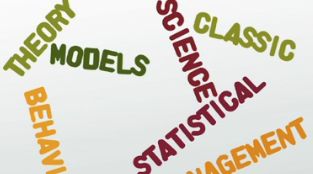Quantitative School of Management: Improving Managerial Decision-Making - Answers
The answers are in BOLD below.
NOTE: The transcript from the video is listed below the quiz for your reference.
1. Was the quantitative school of management born after WWII?
- Maybe
- It was but only after WW I
- No
- Yes
- Managers do not use this method
2. Define what the quantitative school of management strives to do.
- Strives to keep people informed
- Strives to make an even playing field
- Strives to combine classic management theory and behavioral science through the uses of statistical models and simulations
- Strives to help managers that are not good managers
- Makes everyone think harder
3. What is classic management theory?
- Managing old school
- Managing like those before you
- Focuses on how to find the best possible way for workers to perform their tasks
- Taking the classic way of managing and fixing it
- This is not a real type of management
4. Is the behavioral aspect a part of the class management theory?
- Yes
- Only partially
- There is no such theory
- No
- Never
5. Is the behavioral aspect concerned with motivating employees?
- Yes
- Only partially
- There is no such theory
- No
- Never
In order to be effective, managers must make informed decisions. In this lesson, we will help you to understand how managers make decisions using data, models and statistics.
World War Births a New Management Method
No one would ever think that from a war, a new method of management could be born. When we think of wars, there are a lot of images that come to mind - but certainly, new management methods are not one of those images.
 |
However, during World War II, scientists, mathematicians and physicists all got together to solve some military problems (most notably, the atomic bomb). This cooperation and teamwork was the foundation that helped develop the quantitative school of management. Now, you see, management was looked at as a group of systems to improve decision making. I do not think anyone could argue that when your problem is how to split an atom, the decision making has to be very precise and incorporate statistical analysis, information models and computer simulations.
Parts of the Quantitative Machine
The quantitative school of management strives to combine classic management theory and behavioral science through the uses of statistical models and simulations. Wow, let's try to put that in a little more easily-understood terminology. First, we have to understand classic management theory.
 |
Classic management theory focused on how to find the best possible way for workers to perform their tasks. In practice, it was broken down further into two parts: first, how to increase productivity (the classical science branch), and second, how management - or the company - can be organized to achieve productivity (the classic administrative branch). These two areas of focus worked together to develop theories and ideas that helped companies be more effective.
The behavioral aspect came into play when companies started looking at how to motivate, lead and, indeed, manage their employees. Companies realized that people were a part of the equation and needed to be incorporated into the entire process. This part of the process looked at how people behaved and why they behaved the way they did, then blended those findings into management theories to get more out of the workers.
What Decision Making Grew Up to Be
From these beginnings, companies began to look more scientifically at decision making, and not just with reactive thought processes and gut instincts. Quantitative management theory (QMT) began to shape and form specific areas of how decisions could be processed to ensure a more informed result. Since this theory really started with scientists and mathematicians, it's easy to see how a great deal of the theories and processes they developed centered on statistics, models and data to get the best possible result. That thought process pushed the QMT to be structured in the following areas:
- Management science
- Operations management
- Management information systems
- Systems management theory
 |
Let's take a look at these in a little more detail so you can see how they helped shape and develop the quantitative school of management, as well as how decisions are made.
Four Parts of the Process
Management science originally started to treat the problems that could occur or arise with global warfare. (Pretty nice beginning, huh?) In today's world, it encourages and supports managers in using math and statistics to solve problems. When we take a second to think about it, most of the time managers are using statistics and some sort of math (I know we all love math) to better understand problems so they can come up with the right solution.
Operations management focuses on managing the process of blending materials (employees), in the form of labor, and capital (money and equipment) into useful goods or services. In many ways, it can be looked at like a traffic cop directing all the parts of traffic. Materials can go that way and employees can go this way, while capital has to wait for the light to change. In the end, these three areas come together to help the final product leave the factory or be presented to the customer.
Management information systems organize data from the past, present and what could be projected from sources within the company and outside the company, and processes it into usable information. This information helps managers make decisions because it supplies information, such as tracking trends or showing what might happen to a company in 90 days if sales stay the way they are. It literally manages all this information and makes it available for managers to look at, review and analyze.
 |
Systems management theory is a little more basic to understand. It takes inputs, puts them through a transformation process, produces outputs and finally gives feedback on the systems the company is using. That system could be production, or a system for paying their bills or even accounting. If we look at a system like a machine, it is easy to understand the process. Take baking a cake, for example. The cake goes into the oven (input), then the oven heats up and bakes the cake (transformation process), the cake is then taken out of the oven (output) and tasted (feedback). Hopefully, if you did all this right, you have a good-tasting cake as opposed to a door stop or paper weight.
All four of these (management science, operations management, management information systems and systems management theory) can be present in a company to help managers make decisions. Just like our cake example, some people might use more sugar than others to bake a cake, or some may use a different type of oven, but in the end, the cake does get baked. So, these four areas can be present in a company in varying degrees and used by some or all of the departments and managers to help them make decisions.
 |
Lesson Summary
The impact of the quantitative school of management has been tremendous. Literally, it has changed the way managers look at and address issues and make decisions. Before it was developed, managers would go a lot more on gut feeling and history to make decisions. While that worked for some time, as the world grew more competitive, managers had to solve problems in a more exact manner than just guessing.
Think of a situation where you have an older person and a younger one. In today's world, if there is a problem to solve, and the older person presents his or her thoughts based on gut instinct and history (this would be the old classic approach) while the younger person brings in data and systems and reports that show trends, whom do you think the executive team of the company is going to listen to?
So, the quantitative school of management is comprised of many different parts:
The quantitative school of management strives to combine classic management theory and behavioral science through the uses of statistical models and simulations.
Classic management theory focused on how to find the best possible way for workers to perform their tasks and was the predecessor to the quantitative school of management theory.
From there, the quantitative school of management theory developed into four areas:
Management science encourages and supports managers in using math and statistics to solve problems.
Operations management focuses on managing the process of blending materials, employees in the form of labor and capital (money and equipment) into useful goods or services.
Management information systems organize data from the past, present and what could be projected from sources within the company and outside the company and processes it into usable information.
Systems management theory takes inputs, puts them through a transformation process, produces outputs and finally gives feedback on the systems the company is using.
All this allows us to look at problems with more data and make better decisions.